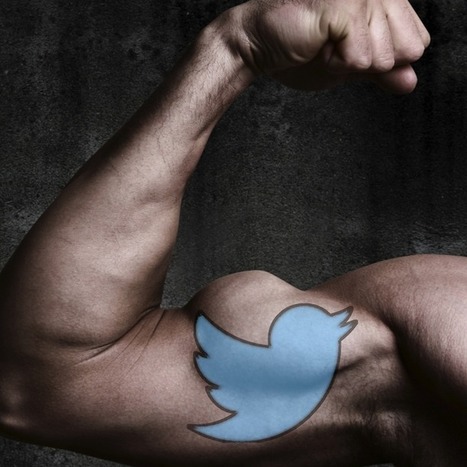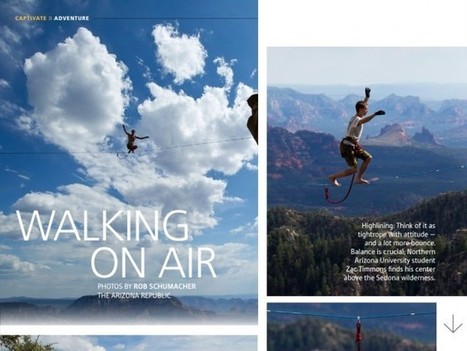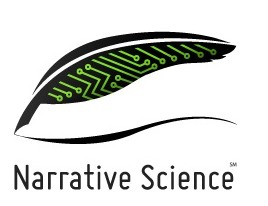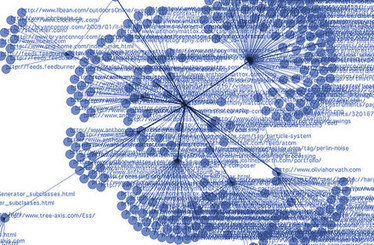 Your new post is loading...
 Your new post is loading...
Digital news continues to evolve, pushed by a variety of innovations in recent years, from groundbreaking new technologies like virtual reality and automated reporting to experiments on social platforms that have altered campaign coverage. As journalists and media practitioners gather for the annual Online News Association Conference, here are 10 key findings from recent Pew Research Center surveys and analyses that show how these rapid digital shifts are reshaping Americans’ news habits...
News organizations are experimenting increasingly with robot journalism, using computer programs to transform data into news stories, or news stories into multimedia presentations.
Most uses of robot journalism have been for fairly formulaic situations — company earnings reports, stock market summaries, earthquake alerts and youth sports stories. But inevitably, news companies will be testing automatic news writing on more challenging subjects.
What are the ethics of robot journalism? When editors consider using automated news writing, what issues of accuracy, quality and transparency arise?
That’s what the surveillance state is trying to do. It has the means, the will and the latitude to go after journalism the way the way it went after terrorism. Only a more activist press stands a chance of resisting this.Last week, the novelist and former CIA operative Barry Eisler published one of the most important posts I have read about what’s happening to the press since the Snowden revelations began in early June.
In it, he tries to explain why authorities in the UK detained Brazilian national David Miranda for nine hours at Heathrow airport and confiscated all the technology he had on him. (Miranda, as everyone following the story knows, is the spouse of The Guardian columnist Glenn Greenwald. He had been acting as a courier, bringing documents on encrypted thumb drives back and forth between Greenwald in Brazil and his collaborator, Laura Poitras, in Germany.)Eisler’s explanation of this pivotal event is the most persuasive I have seen....
What's up with traditional media and what's buzzing in digital media? A very interesting analysis... It’s been a good week for old media. The Guardian, The Washington Post, The New York Times, and The Wall Street Journal have all done a superb job of reporting on the NSA/PRISM revelations. Unfortunately it has also been a terrible decade for them. Newspaper advertising revenue has fallen by more than half since 2007, and paywalls aren’t even coming close to covering that loss.Worse yet, nimbler competitors are doing their breakneck best to steal the audience…and they seem to be doing it well.
I recently got curious about how frequently various news sources are shared on social media, and since I couldn’t find any tool that measured quite what I wanted, I built one myself. (And I’ve spent like a hundred dollars on App Engine server costs amassing all of its data, so I hope you appreciate this.) The results were eye-opening.My handy-dandy tool, called Scanvine, tracks stories from a panoply of online sources, measures how often they’re shared, and compares and ranks them all. Guess what its leaderboard says as of this writing? None of the above are ranked in the top three. Nor the NYT, or the WSJ, or the New Yorker. Instead, third place goes to The Onion, with an average of 2000 shares per story; number two is Cracked, with 2700; and number one, at over 3000…is much-loathed BuzzFeed....
Not long ago, the media looked at the web as if it was an awkward, unwanted stepchild. Today, the reverse is arguably true, with debate growing over whether social networks such as Twitter will overtake beacons of journalism like The New York Times. At last month's Milken Institute Global Conference, PayPal co-founder Peter Thiel said he thinks Twitter will outlast The Times. His reasoning: Its business strategy is more solid than that of the storied newspaper. The debate got journalists talking on forums such as Muck Rack, with many people disagreeing. Some said it isn't a mutually exclusive relationship, or that one's success is predicated on the other's failure....
At this point, there’s no shortage of mobile products created by newspapers. Staffs are developing general news apps, sure, but in many cases they’re also tacking on a host of more niche apps. They’re also being more thoughtful about the types of journalistic content suited for mobile consumption and the extent to which clean presentations make this content sing. The apps that resonate with me most play up the functionality of the device, are useful to readers, and give information to help citizens lead better lives on the go. Newspapers, I believe, are learning that what works on a smartphone is different than what works on a tablet. What’s a helpful app in Los Angeles is different than what passes for a helpful app in Cleveland. And a newspaper staff that understands their community is better positioned than most to make these sorts of product adjustments to suit the market. Having said that, here are my picks for best newspaper apps. I listed my selections by newspaper and then explained the particular app or apps by that publication that stand out. Some have excelled in apps that are geared toward more lifestyle topics while others have done well with more traditional news coverage. All the apps are free of charge (or free for a limited time), which goes against the business model of most papers who are starting to charge for apps of their news content....
New media companies -- from Gawker to Buzzfeed -- have sprung up to feed every niche (and then some). Which are actually profitable? FORTUNE -- The web has given rise to a number of notable digital publishers serving almost everyone's tastes, from straightforward news to guilty pleasures. For every Pulitzer-winning 10-part series on wounded war veterans, there are just as many frothy posts like the "10 funniest cat GIFs of the week." What about earnings? Some like The Awl have been profitable from the outset; others like Vox Media predict they'll be in the black soon. Here's a snapshot of just several new media businesses and how they're doing....
A chart making the rounds this week showed that annual newspaper advertising revenue has fallen from a high of more than $60 billion around 2000 to about $20 billion in 2011. Stunning, yes. Put that chart against ASNE’s annual survey of newspapers’ newsroom employment and you see see something else: Newspapers employ about the same number of journalists as in the late 1970s, and they’re paying for them with roughly the same amount of advertising revenue as in the 1950s. How’s that for confirmation that journalists are doing more with less? The chart posted by University of Michigan professor Mark J. Perry showed that print advertising revenue is at a 60-year-low, just over $20 billion....
Breaking news has long been part of Buzzfeed's DNA (it describes itself as embodying "a pioneering mix of breaking news, entertainment, and shareable content"); the idea that one staffer would be dedicated to it, though, was a product of evolution. "It took us a little while to figure out how breaking news works on the social web and how it travels," Smith says. Now that it's doubling down on breaking news, Buzzfeed will have the challenge and the opportunity that every startup does: It isn't weighed down by institutional history. It can -- and in some sense it has to -- invent new approaches to breaking news. And one way it will do that is to take a slightly meta view of what a "breaking news story" is in the first place. The 5 W's -- a Buzzfeed-y list if ever there was one -- may work for wire services, but they're not enough for an organization that puts itself so implicitly in dialogue with the social web. "You have to be really transparent," Smith says. "The information is part of the story now in a way that it didn't use to be."...
For a time, Gabrielle Giffords was dead. So was Newtown, Connecticut, shooter Adam Lanza’s father. Or maybe it was his brother in Hoboken, New Jersey. All three, as we now know, are alive. Two of them weren’t even shot. On the other hand, the alleged Boston Marathon bomber is, actually, under arrest. Then he wasn’t. Then he was. How does the news get it so wrong? I’ve spent almost 20 years as a reporter and anchor and have covered more live, fast-breaking stories than I remember. Mistakes happen regularly on cable news because of the inexact and unreliable nature of rolling coverage. But most of the mistakes don’t matter: the exact color of the car, the exact price of the stock, the exact quote from the courtroom. Ultimately, they all get corrected, as rumor and speculation give way to provable fact and hard evidence. Most of the mistakes end up being of little consequence. But the details surrounding the Boston bomber mattered, because the nation was so heavily invested. Americans were on edge, their sense of safety shattered again. Public anxiety was at its height when the news of an arrest first came. The news, it turns out, was wrong. And this one didn’t fix itself....
Guardian digital development editor Joanna Geary answers some questions about GuardianWitness.... ...First up: this was built in two months. The sponsorship pot from EE gave them a budget and time to get the job done, but not necessarily have everything they wanted at launch. She says it's a complete, working system that can be built upon. I suggest the phrase "minimum viable product" to Jo but she suggests that it's a full product - one that will be built on. Do they have aspirations for more integration with social media? Yes, they do. And it's something they're looking at as the system develops. The key part of the development which is invisible to us right now is that the Guardian Witness system is deeply integrated with the Guardian's CMS. Once the content has passed through verification, it's available to the journalists, and they can insert it into a story or liveblog just by inserting an URL, which creates an embedded version of the contribution that links back to the contributor's profile. "The really exciting thing is not what you see now, but what you see when Witness is included in a story," she says. It's a tool to facilitate genuine collaborative working between the journalist and external witnesses. Jo says they'll collaborate with people on the ground, or with expert knowledge, in any way they can - and already do, via phone and other traditional methods. This adds another tool for doing that....
In the wake of the Boston Marathon, I have but one ask for the media: please tell us NO.... ... While Twitter might offer up a 6-second video of one of yesterday’s horrific explosions, it’s your profession that is charged with relaying that information. In the race for clicks, pageviews, and traffic, I’ve seen the most trusted news sources with banner three-letter monikers devolve into sensationalized sites catering to this now now now generation’s demand for anything. “Anything — just give us anything,” we cry. But it would be lovely if you told us “no.” No – we will not capitalize on over-graphic images that would get a Hollywood blockbuster an R-rating. No – we will not use cultural or nationality indicators when reporting that there is a suspect in custody. Why? Because we know the most important words in those statements are “in” and “custody” as opposed to where one was born or the depth of one’s suntan....
Every 30 seconds or so, an algorithm developed by Narrative Science produces a computer-written news story, Wired reports. The articles run on the websites of respected publishers like Forbes, as well as other Internet media powers (many of which are keeping their identities private). Niche news services hire Narrative Science to write updates for their subscribers, be they sports fans, small-cap investors, or fast-food franchise owners. And the articles don’t read like robots wrote them....
|
Election night is the time when everyone has CNN on. We’re the place to go for TV and digital, and we also want to be the place to go on social. We’re working on that, and we have a lot of fun things planned for election night.
We’re going to be very conscious of reaching our audiences across Facebook, Snapchat and Twitter. But we’re also going to live up to the CNN standard. We will work together as a multi-platform media company to make the calls at the right time.
We saw this play out in the primaries, where we made the calls across TV, digital and social at the exact same time. So we work together as a unit to make sure as a network, we make that call in unison. The same will happen on election night. All of social and digital and TV will be working to make sure there’s a crescendo of results as they happen....
Industry experts from the BBC, CNN, ITV News, Trinity Mirror and The Washington Post share their predictions for the key trends in digital journalism this year.We asked five industry experts from local, national and international news outlets to share their predictions for digital journalism in 2014.
The 10 key trends they identified include short-form video, private social media, drone journalism, responsive design and new apps and devices...
I recently gave a presentation at the Digital Innovators Summit in Berlin on how FORBES is disrupting the traditional news media.
My solution was to tell the FORBES story of the last 20 months — the successes, challenges and learnings of a 95-year-old startup helping to lead journalism into the future.
I’ve boiled it down to nine key points that capture what we’ve done to reinvent Forbes.com and put our authoritative journalism at the center of a unique social media experience....
...The starting point to understanding the how mainstream media fails to accurately report the news is the consolidation of media ownership in the United States. In 1983 50 corporations controlled the vast majority of all news media in the U.S. In 2002 that number had decreased to 10 companies (McChesney & Nichols, 2002). By 2004 that number had decreased to only five companies. As Nichols and McChesney state, All in all, these [few] firms control the overwhelming percentage of movies, TV shows, cable systems, cable channels, TV stations, radio stations, books, magazines, newspapers, billboards, music and TV networks that constitute the media culture that occupies one half of the average American’s life.
It is an extraordinary degree of economic and social power located in very few hands (Nichols & McChesney, It's the Media Stupid, 2000, p. 28).Five companies control the bulk of information disseminated to the American public via mainstream media. How can one have a diverse discussion of ideas if a handful of people or, in the case of the media, a handful of corporations controls the information that the public receives via mainstream media? The answer is that one cannot. Corporations have one interest in mind: Profit above all else. Financial gain is their only reason for existence. Informing the public is not the corporate media’s principal function, making money is....
What You Can Learn From Profitable New Media Companies.... It ain’t easy being in the media business these days, or so they say. There are in fact lots of people allegedly, or actually, raking in digital dollars, according to this article from Fortune. They’re all content producers with a journalistic twist. They are all different in their own ways, but you can parse out some ingredients for financial success in the industry. Not surprisingly the top, profitable companies are: The Huffington Post, Gawker Media, The Awl, Business Insider, SAY Media, Vox Media, and BuzzFeed. So what sets them apart?...
BuzzFeed gets free content, users get exposure, we get 11 Engagement Photos That Will Make You Happy You’re Single. ... The department devoted to creating this “old school” content is known as BuzzTeam. Their focus is anything shareable — lists, animals, nostalgia. The kind of content that BuzzFeed’s loyal readers have become hyper-familiar with. Many, in fact, have consumed so many such BuzzFeed posts that they’ve become adept at mimicking both their tone and their viral success. Earlier this month, BuzzFeed’s editors took a step toward giving those faithful followers a little more of the spotlight they crave. Shepherd, along with a staff of four, now run BuzzFeed Community, a content-producing vertical of its very own, complete with featured posts by community members and a leaderboard with the latest on who’s posts are getting the most traffic, likes, comments, and badges. It’s a competitive place, and anyone can join and enter the fray....
When it comes to the traditional media business, there is often a pervasive nostalgia for “the good old days,” when a handful of newspapers and TV networks ruled over the media landscape and profitability was so taken for granted that huge family dynasties with names like Sulzberger and Bancroft were built on that foundation. Many media executives no doubt dream about magically returning to such a time. But what if those days were just an illusion — a kind of accident of history? What would that mean for the future of media? This idea has come up before, but I was reminded of it when I read a Nieman Journalism Lab post about some research being done by Lee Humphreys, looking at the way that communication — and particularly personal communication, through letters and diaries and other pre-digital tools of expression. Although this doesn’t seem to have much to do with how we use ultra-modern services like Twitter or Facebook, there is a lot more to it than you might think....
...Yesterday Reuters unveiled a preview site for the future look and design of Reuters.com; it had given a sneak peek earlier. It’s a river-of-news type of approach that mirrors the flow of data on one of Reuters terminals, but has also become increasingly popular in the era of social media. Go to an article page and you find that you’re actually placed in the middle of a larger stream of content — scroll up or down and you’ll find your story’s text actually lives in a bifurcated version of the Reuters front page. If every page is your homepage, why not treat them all like one? The team responsible for the new site and apps sees the project as less of a redesign and more of a rebuild: Instead of adding new flooring and fixtures, they’ve taken the house down to the foundation. (See below for more.) “This goes back to the history of Reuters. This news organizations has access to so much information being delivered in real time,” said Jim Roberts, executive editor for Reuters Digital (and until recently of The New York Times). The goal of the new digital products is to merge the worlds of traditional newsgathering and social media: “I’m also a fan of what social media is doing to conventional media to have the ability to smartly inform people in real time about the information we are creating with our 2,800 journalists.”...
The media industry may be hurting, but journalism -- and access to information -- is flourishing. Journalists may just have to work smarter, and network more, to keep up.... Journalism is not in crisis. The media industry — and journalists — might be, but the journalism itself is actually improving. Such is the argument made by international documentary filmmaker Bregtje van der Haak and Annenberg professors Michael Parks and Manuel Castells in a recently published article about “Networked Journalism.” As the authors see it, the problem is that most of the doomsayers mix the concept of journalism with the business of journalism. In their article, journalism is defined as the “production of reliable information and analysis needed for the adequate performance of a democratic society.” Not mentioned in the definition are “profits,” “professional journalists” or “traditional publishers.” Just the pursuit of reliable information....
Traditional news organizations need to embrace the disruption brought by digital culture -- or they risk becoming obsolete. That was the message late last week at the International Symposium on Online Journalism hosted by the Knight Center for Journalism in the Americas at the University of Texas at Austin, where about 370 of the world's journalists, researchers and media watchers grappled with the hard questions for a beleaguered traditional media industry that is now more than a decade into its disruptive transformation. The problem is many media companies view digital technologies through a lens of traditional journalism and thus, fail to strategize properly, said Clark Gilbert, president and CEO of Deseret News Publishing Company. "In a post-disruption world, why would people pick up a paper at all? Why would someone turn on the 10 o'clock newscast?" Gilbert asked. "If you are not asking those fundamental questions, there is not a future for you legacy organization." The key to surviving? Innovate. Fail. Innovate again....
Natural disasters, airline crashes — and yes, terrorist bombs — undercut the normalcy of everyday life by bringing death’s whammy to an unexpected place at an unforeseen time. In the hours and days following such catastrophes, journalists work to restore normalcy to the panicked population by explaining how and why the bad thing happened and how to prevent it from happening again. Reporters have been normalizing the abnormal for so long that they’ve created well-worn catastrophe templates to convey their stories. Yesterday, while covering the Boston Marathon bombing, journalists leaned hard again on those templates. First came the sputtering dispatches over radio and television about the calamity. Next up were the on-the-scene broadcast reports, frequently marred by confusion and contradiction, as the press held out hope for survivors but prepared audiences for the worst. Video of the catastrophe was converted by the cable news networks into a perpetual loop, giving the talking heads a wallpaper background to talk over (and giving new viewers just tuning in something graphic to watch)....
Terrible events such as yesterday’s bombings at the Boston Marathon have always meant “all hands on deck” for news organizations, with staffers pulled off their regular beats to contribute. But the endpoint of the newsgathering and reporting is no longer a front-page package of stories explaining — the best one can — what happened, why it happened and what might be next. Now, there is no endpoint — events are reported in real time, with stories in constant motion, and the front page is a snapshot of an organization’s reporting at the moment when the presses needed to roll. Boston was a reminder of that, and a look at what’s changing in real-time journalism. Through Twitter and various live blogs, I found myself looking over my shoulder at the Boston Globe, the New York Times, Reuters and other news organizations, and was able to make some observations and draw some conclusions....
|



 Your new post is loading...
Your new post is loading...

































Pew Research provides valuable insight into the changing digital news landscape. rrecommended reading for PR, journalists and marketers. 9/10